Lakewood Vineyards
by
K.L. Sullivan
Synopsis: Lakewood Vineyards, on the west side of Seneca Lake is easy to find. Set back from the road, the long low wood-sided building with an apex on each end, sits slightly above acres of vineyards. Lakewood offers dry whites and reds, semi-dry white, semi-sweet and sweet wines. Family friendly, with a small knowledgeable staff, the winery makes wines approachable.
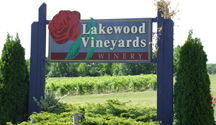 Located on the west side of Seneca Lake, Lakewood Vineyards is located on a gradual slope towards the blue body of water. It wasn’t long before we were out enjoying the sunny day walking through the vineyards, observing the differences between various varietals.
Located on the west side of Seneca Lake, Lakewood Vineyards is located on a gradual slope towards the blue body of water. It wasn’t long before we were out enjoying the sunny day walking through the vineyards, observing the differences between various varietals.
Lakewood Vineyards is proud of its fourth generation winery. Beginning in 1952 with the planting of 74 acres of vineyards, grapes were produced by 1955. At that time, the vineyards were for the production of juice grapes. When the company, the grapes were sold to, moved to California, the family faced a major decision, sell the farm or plant wine grapes. Changing to wine grapes meant pulling out older established vines.
By June 1989, production of wine was begun using vintage grapes from 1988. By 1993, the winery added a screw press so that the entire process could take place on location. Two years later, another press was purchased.
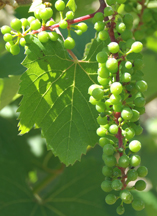
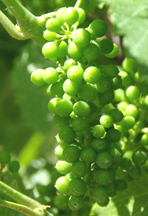 Liz Stamp is in charge of Public Relations, while her mother-in-law is the manager and accountant with the unlikely alias “bean counter.” Both are friendly and representative of the camaraderie one will find at Lakewood’s tasting room. As Liz said, “We like what we do.” Liz’s husband, Chris, the family’s third generation to work at the winery and vineyards, is the winemaker.
Liz Stamp is in charge of Public Relations, while her mother-in-law is the manager and accountant with the unlikely alias “bean counter.” Both are friendly and representative of the camaraderie one will find at Lakewood’s tasting room. As Liz said, “We like what we do.” Liz’s husband, Chris, the family’s third generation to work at the winery and vineyards, is the winemaker.
Liz took us on a tour of the vineyards identifying various grapes for us and mentioned differences between the grapes, whether it was the color of the undersides of the leaves or the red or green stems of the grapes.
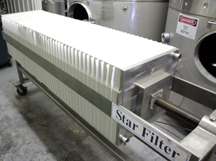 The winery has expanded since 1989, with an addition to the building and additional equipment including a large new filter. The assistant winemaker took time to explain how the filter worked. Next, we went into the barrel room where we saw various oak barrels including ones made from New York oak. These were the first barrels we have seen made from New York oak and the staff is pleased with the success of the wine aged in these oak containers. Chardonnay at Lakewood Vineyards ages for three to three and a half years.
The winery has expanded since 1989, with an addition to the building and additional equipment including a large new filter. The assistant winemaker took time to explain how the filter worked. Next, we went into the barrel room where we saw various oak barrels including ones made from New York oak. These were the first barrels we have seen made from New York oak and the staff is pleased with the success of the wine aged in these oak containers. Chardonnay at Lakewood Vineyards ages for three to three and a half years.
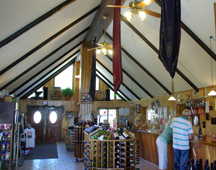 The tasting room is large with two tasting areas. Numerous items are available to peruse including wine displays. Gifts and accessories to purchase include picnic packs, candles, decorated lighted wine bottles, bottle lamp kits, clothing and snack foods. Also in the tasting room is a small toy area to occupy young children while wine tasters enjoy the available wines.
The tasting room is large with two tasting areas. Numerous items are available to peruse including wine displays. Gifts and accessories to purchase include picnic packs, candles, decorated lighted wine bottles, bottle lamp kits, clothing and snack foods. Also in the tasting room is a small toy area to occupy young children while wine tasters enjoy the available wines.
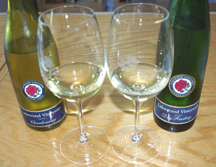 We tasted several wines and talked about the “body” of the wines. Chardonnay begins with a fruit and acid taste and finishes with oak and butter. The Riesling had a mineral and fruit flavor with a slight fizz. Carpe Vinum (Cayuga White) with 1.1 residual sugar is light with a slight fizz, a sweet fruit taste and sweet aftertaste. Pinot Gris 2006 was sweet with 1.8 residual sugar, a slight fizz and a fruit aftertaste. The Riesling had the lightest body while the Chardonnay was the fullest bodied.
We tasted several wines and talked about the “body” of the wines. Chardonnay begins with a fruit and acid taste and finishes with oak and butter. The Riesling had a mineral and fruit flavor with a slight fizz. Carpe Vinum (Cayuga White) with 1.1 residual sugar is light with a slight fizz, a sweet fruit taste and sweet aftertaste. Pinot Gris 2006 was sweet with 1.8 residual sugar, a slight fizz and a fruit aftertaste. The Riesling had the lightest body while the Chardonnay was the fullest bodied.
Pinot Noir 2002 has an earthy flavor - mushroom and red berries. Cabernet Franc was very acid with a dark fruit taste. Long Stem Red is a blend of Baco Noir, Leon Millot, Dechaunac, and Vincent, with medium body and fruity aftertaste. This is good for summertime barbeques even hot dogs and hamburgers.
Lakewood also produces a port made from the Baco Noir grape.
Currently, Lakewood Vineyards produces 36,000 gallons (over 15,000 cases) of wine and sells 65 to 70 percent in the tasting room.
When you visit you will find a relatively small staff that has been with the winery for a long time. Everyone can answer almost any question. They are very family friendly and they make wines approachable.Lakewood Vineyards
Watkins Glen, New York
